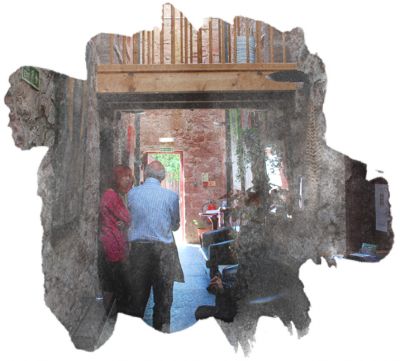Cromarty
"Old houses, crow-stepped gables, sweet old-fashioned gardens, a huddle of grey roofs along the shore, a church tower, a foreign-like cupola on the tower of the Town House, a cloudless sky and a sapphire sea, with the bold bluff of the Sutor standing like a sentry to guard the gateway of the Firth." – T. Ratcliffe Barnett, 1942
"For Cromarty of old was full of seafaring men, captains courageous, navy men who had suffered from the pressgang, and douce kirk-going burghers. Then it was in close touch with foreign parts. Now that the fishing has failed and gone elsewhere, it is like an old man dovering in the sunshine, the grey roofs and the warm pink stone of the houses reminding us of his grey hair and his rosy cheeks. For that very reason here is an ideal resting-place for those who would spend a quiet holiday and relax in the caller winds of the sea-blown burgh after the stress of a city life."
"But for me the rarest sight in Cromarty is a humble little thatched cottage with a crow-stepped gable turned to the street. Here Hugh Miller was born. He began life as a working mason, and, as he tells us in one of his books – My Schools and Schoolmasters – he was practically a self-educated man. He had a passion for geology, and found many of his most famous fossils in the Old Red Sandstone, especially in the neighbourhood of the Ethie Burn."

The rocks in which Hugh Miller found his fossils were the sediments of an ancient lake that once stretched north to Orkney and Shetland and east to Norway. It is called today Lake Orcadie, and it formed around 380 million years ago, in the middle of the Devonian period, a time when all the earth’s large animals were living in the sea. Parts of the story of the lake can still be seen today in imprints on the rocks such as ripple-marks and mud-cracks from events of long ago. Occasionally, something happened to kill off large numbers of fish in the lake, and their bodies form the fossil remains studied by Hugh Miller and others. From the fossil fragments, the shapes of the fish themselves can be reconstructed. Hugh Miller wrote of:
“boat-like animals, furnished with oars and a rudder; fish plated over, like the tortoise, above and below, with a strong armour of bone, and furnished with but one solitary rudder-like fin; other fish less equivocal in their form, but with the membranes of their fins thickly covered with scales; creatures bristling over with thorns; others glistening in an enamelled coat, as if beautifully japanned.”
The biggest of these fishes was the Asterolepis – a member of the coelacanth family over six metres long. It has a large thickset head, and powerful jaws with teeth found in later ages in crocodiles. At the back of its throat is a little bone, shaped like an old-fashioned roofing nail. Hugh Miller found one of these fossil bones on a fine midsummer evening outside Stromness in Orkney, and he gave his book Foot-prints of the Creator the subtitle The Asterolepis of Stromness.

 The Travelling Scholars | sitemap | log in
The Travelling Scholars | sitemap | log in
 The Travelling Scholars | sitemap | log in
The Travelling Scholars | sitemap | log in